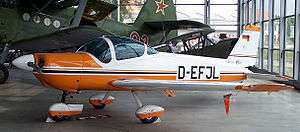MBB Bo 209
| Bo 209 Monsun | |
|---|---|
 | |
| Role | Civil utility aircraft |
| Manufacturer | Bölkow; later MBB |
| First flight | 22 December 1967 |
| Number built | 102 |
The MBB Bo 209 Monsun (originally the MHK-101) is a two-seat light aircraft that was developed in Germany in the late 1960s.
Design and development
The design started as a redesign of the Bo 208 under Bölkow technical director Dr Hermann Mylius but resulted in a vastly different aircraft with little commonality of parts with its predecessor. The fuselage was now wider and incorporated a retractable nose wheel. The wings were redesigned and relocated to a low-wing configuration (the Bo 208 was a high-wing aircraft) and made foldable for towing and storage. The aircraft was marketed with a choice of the fixed or retractable nose wheel, either a 150-hp or 160-hp Lycoming engine, and an optional variable-pitch propeller. A trainer version with dual controls was also manufactured.
With this broad array of equipment options Bölkow displayed the aircraft at the Air Show in Hanover 1970: 57 orders of the new type were drawn in advance. A commercial success of the project seemed secured, but the fusion of the Bölkow GmbH into the MBB company 1968 led to the economic decision to stop building civil aircraft. Although there were 102 Monsun manufactured between 1969 and 1971. A United States businessman invested in the model, secured funding, and started shipping factory equipment to Georgia. Before completion of the transition, the investor committed suicide after losses in stock market speculation.[1] MBB decided in February 1972 to stop production despite there still being 275 orders outstanding.
In the late 90's Dr. Mylius's son, Albert Mylius, completed a totally revised version of his father's design under a new company "Mylius Flugzeugwerk GmbH & Co KG" based in Bitburg. Two models were produced: a single seat developed as a low cost aerobatic airplane (MY-102) and a two-seat (MY-103) Mylius Aircraft which has some variations over the original Bo 209 design, like wider cockpit, better handling characteristics and improved overall performance (including aerobatic rating) with a more powerful 200HP engine.
Variants
- MHK-101 prototype
- Bo 209-150 - production version with Lycoming O-320-E1C engine
- Bo 209-160 - production version with Lycoming O-320-D1A engine
- Bo 209S - trainer version with dual controls, non-retracting nosewheel, and non-folding wings
Specifications (Bo 209-160)
Data from Jane's All The World's Aircraft 1971-72
General characteristics
- Crew: one pilot
- Capacity: 1 passenger
- Length: 6.60 m (21 ft 7¾ in)
- Wingspan: 8.40 m (27 ft 6¾ in)
- Height: 2.20 m (7 ft 2½ in)
- Wing area: 10.2 m2 (110 ft2)
- Empty weight: 484 kg (1,067 lb)
- Gross weight: 820 kg (1,807 lb)
- Powerplant: 1 × Lycoming O-320-D1A, 119 kW (160 hp)
Performance
- Maximum speed: 274 km/h (170 mph)
- Cruising speed: 243[2] km/h (150 mph)
- Range: 1,200 km (745 miles)
- Endurance: 5 hours 14 min
- Service ceiling: 5,520 m (18,100 ft)
- Rate of climb: 6 m/s (1,180 ft/min)
See also
- Aircraft of comparable role, configuration and era
Notes
References
| Wikimedia Commons has media related to Bölkow Bo 209. |
- Taylor, John W.R. (ed.) (1971). Jane's All The World's Aircraft 1971-72. London: Jane's Yearbooks. ISBN 0-354-00094-2.
- Taylor, Michael J. H. (1989). Jane's Encyclopedia of Aviation. London: Studio Editions. p. 192.
- Simpson, R. W. (1995). Airlife's General Aviation. Shrewsbury: Airlife Publishing. p. 85.